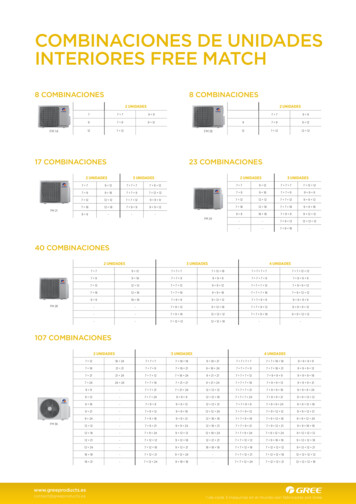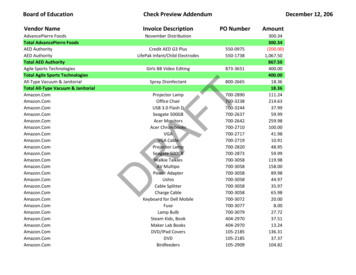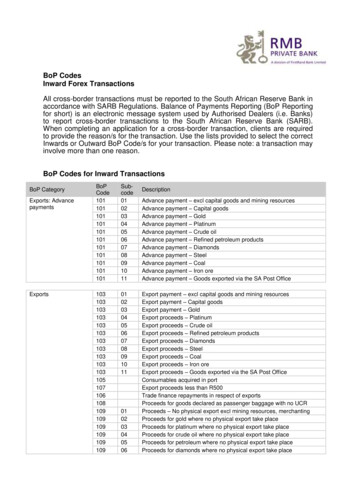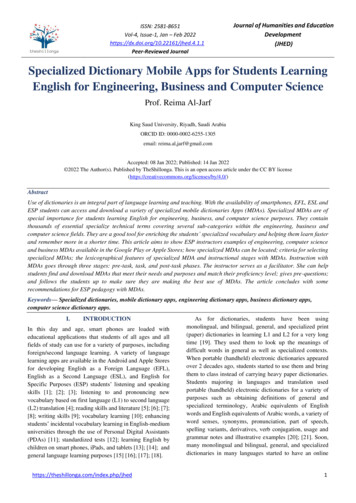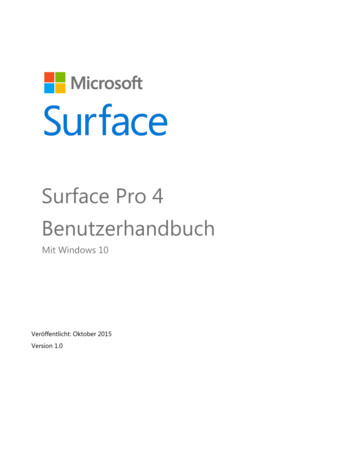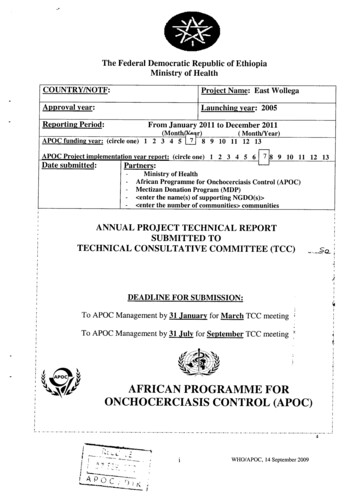
Transcription
The Federal Democratic Republic of EthiopiaMinistry of HealthCOUNTRY/I.{OTF:Proiect Name: East WollegaApproval year:Launchins year: 2005From January 20ll to December 20llReporting PeriodAPOC fundine vear: (circle one)(Monthpz"lp;( Month./Year)7I 23458910111213ArDate submittede one1234567910111213Partners:Ministry of HealthAfrican Programme for Onchocerciasis Control (APOC)Mectizan Donation Program (MDP) enter the name(s) of supporting NGDO(s) enter the number of communities communitiesIiANNUAL PROJECT TECHNICAL REPORTSUBMITTED TOTECHNICAL CONSULTATIVE COMMITTEE (TCC)I!iIi--,**sa, i ;tiI-4'*xt ntI.i:{DEADLINE FOR SUBMISSION:To APOC Management by 31 Januarv for March TCC meeting,tIiPfu?rAAI ril,iqe tittl::iI:To APOC Management by 31 Julv for September TCC meeting,'i].i hfi;rr.'." t'"' tr, R.IS .tj*IIAiAFRICANPROGRAMME FORONCHOCERCTASTS CONTROL (APOC)I!jtIj,."I{WHO/APOC, 14 September 2009.' , -; ''-.'\iIt4 pri,fli .
-II:ANNUAL PROJECT TECHNICAL REPORTTOTECHNICAL CONSULTATIVE COMMITTEE (TCC)III!I!!iENDORSEMENTII:!iiiPlease confirm you have read this report by signing in theappropriate space.IiII:IIiIOFFICERS to sign the report:Country: EthiopiaNationalCoordinatorName: MihretHilufSignatureDatelZonal Oncho Coordinator Name: .Ato Insermu JalduSignatureDateNGDO Representative Name: Ato DubiwakGemedaSignatureDate:This report has been prepared by Name :Ato DubiwakgemedaDesignationSignature : .IIDatellIWHO/APOC, 14 September 2009
,N'd\\c'T'-"-lANNUAL PROJECT TECHNICAL REPORTTOTECHNICAL CONSULTATIVE COMMITTEE (TCC)ENDORSEMENTPlease confirm you have read this report by signing in theappropriate space.OFFICERS to sign the reporf:Country: EthiopiaNationalCoordinatorHilufIllihdt Hiluf Nigrrule(RN, BSc, tfI'H)and Ft"'''Signature : . . . r.ff.Y3.,L*,.,*.n Hc:ithFPloruof ion-"trsi,alnDlrccFr.:1.::.Name: MihretDate.1-s}'n".)PflV.'.r;irf a/c:t'Zonal Oncho Coordinator Name: . . . Ato InsermuI)t(Ve!tt.Tf"'-5r'iII:t)G,(.Date:NGt\ /. Signahue.:L!4.,kName: Dr. Zerhun Tadesse:,t'?.: I rC - is i.t'I'lIII,ttti'Thi S reportSignature,Date:3::.t {:Itol*-[kt]!!IIIby Name :Ato Dubiwak \IIWHO/APOC,l4September 2009I.\l.
Table of contentsACRONYMS.vDEFINITIONSVIFOLLOW UP ON TCC RECOMMENDATIONS7EXECUTIVE SUMMARY .l:.8INFORMATION.1l.l. GpNpRar- rNFoRMATroN.11.1.1 Description of the project (briefly). I1.1.2. PartnershipError! Bookmark not de/ined.1.2. Popu1arroN.3SECTIONBACKGROUND.SECTION 2: IMPLEMENTATION OF CDTI. ERROR! BOOKMARK NOT DEFINED.2.1. Tlvprtxp oF ACTrvtrrES .Ennon! BooruaRr xor DEFINED.2.2.Aovocacy2.3Mogtl.tzerloN, SENSITIZATIoN2.42.52.6.Couuuxry.6AND HEALTH EDUCATIoN oF AT RISK coMMUNITIES . gures.2.6.2 lIthat are the couses of absenteeism?.2.6.t.2.6.32.6.4Wat are the reasons for refusals? .Briefly describe all known and verified serious adverse events (SAEs) that2.6.5. Tre nd of tre ot me nt ac h i ev e me ntfro m CDTI project inception to the current year I42.7. ORoERtNc, sroRAGE AND DELTvERv oF IVERMECTIN. t52.8. CouuuNny sELF-MoNrrozuNGAND STAKEHoLDERS Mrsrruct62.9. SuppRvrsroNt62.9.1. Provide aflow chart of supervisionl72.9.2. Ilhat were the main issues ide nt ifi e d dur ing supe rv i s i o n?t72.9.3. Was o supervision checklis 't used?l72.9.4. V[hat were the outcomes ot each level of CDTI implementation supervision? l72.9.5. l{as feedback given to the person or groups supervised?2.9.6. How was the feedback used to improve the overall performance of the project?l7I7SECTION 3: SUPPORT TO CDTI3.1.EeurpvpNr.FruaNcral coNTRTBUTIoNS oF THE pARTNERS AND coMMUNITrES.OrupR FoRMS oF coMMUMTy suppoRT.ExpeNorruRE pER AcTrvrry3.2.3.33.4.t7l82323SECTION 4: SUSTAINABILITY oF CDTI.234.1. INrenNal; INDEpENDENT pARTICTpAToRy MoNIToRTNc; EvalunuoN.4.1 . I Has the proiect ever been evaluated/monitored? (fickany of the folowing whichare applicable) .,,234.1.2.4. 1.3 .4.2.Wat were the recommendations?How have they been implemented?.SustalNaalLrry oF pRoJECTS: pLAN AND sET TARGETS (MANDAToRy AT .IYn 3) .23.23.24.242illWHO/APOC, l4 September 2009
4.2.1.4.2.2.Planning at all relevant levelsFunds.; ;,:; i u;;,,;, ;;,,; ;;; d,n,:;.(replacement4.2.3 Transportand maintenance)Error! Bookmark not de/ined.4.2.4. Otherresources.Error! Bookmark not defined.4.2.5. To what extent has the plan been implemented264.3. INrecRerroN.264.3.1. Ivermectin delivery mechanisms264.3.2. Troining264.3.3.Joint supervision and monitoringwith other programs264.3.4.Release offunds for project activities264.3.5.Is CDTI included in the PHC budget?264.3.6. Describe other heolth programmes that are using the CDTI structure and howthis wos achieved. What have been the achievements? .274.3.7. Describe others issues considered in the integration of CDTI.274.4. OppnarroNAl RESEARCH.304.4.1. Summarize in not more than one half of a page the operationol researchundertoken in the project orea within the reporting period. 304.4.2. How were the results applied in the project? .30;i ;;SECTION 5: STRENGTHS, WEAKNESSES, CHALLENGES, AI\DOPPORTUNITIES.30SECTION 6: UNIQUE FEATURES OF THE PROJECT/OTHER MATTERS.31lvWHO/APOC, 14 September 2009
AcronymsREMOAfrican Programme for Onchocerciasis ControlAnnual Treatment ObjectiveAnnual Training ObjectiveCommunity-Based OrganizationCommunity-Directed DistributorCommunity-Directed Treatment with lvermectinCommunity Self-MonitoringLocal Govemment AreaMinistry of HealthNon-Governmental Development OrganizationNon-Governmental Organ izationNational Onchocerciasis Task ForcePrimary health careRapid Epidemiological Mapping of OnchocerciasisSAESevere adverse eventSHMTCCStakeholders CUTGTechnical Consultative Commiffee (ApOC scientific advisory group)Trainer of trainersUnited Nations Children's FundUltimate Treatment GoalwHoWorld Health OrganizationTOTUNICEF.}VWHO/APOC, 14 September 2009
Definitions(i)(ii)Total population: the total population living in meso/hyper-endemic communitieswithin the project area (based on REMO and census taking).Eligible population: calculated as84%oof the total population inmeso/hyper-endemic communities in the project area.(iii)Annual Treatment Objective: (ATO): the estimated number of persons living inmesolhyper-endemic areas that a CDTI project intends to treat with ivermectin in agiven year.(iv)Ultimate Treatment Goal (UTG): calculated as the maximum number of people tobe treated annually in mesoftryper endemic areas within the project area,ultimately to be reached when the project has reached ful1 geographic coverage(normally the project should Ue explctld to reach the UTG at the end of the 3'dyear ofthe project).(v)Therapeutic coverage: number of people treated in a given year over the totalpopulation (this should be expressed as a percentage).(vi)GeoEraphical coverage: number of communities treated in a given year over thetotal number of meso/hyper-endemic communities as identified by REMO in theproject area (this should be expressed as a percentage).(vii)Integration: delivering additional health interventions (i.e. vitamin A supplements,albendazole for LF, screening for cataract, etc.) through CDTI (using the samesystems, training, supervision and personnel) in order to maximise costeffectiveness and empower communities to solve more of their health problems.This does not include activities or interventions carried out by communitydistributors outside of CDTI.(viii)Sustainability: CDTI activities in an area are sustainable when they continue tofunction effectively for the foreseeable future, with high treatment coverage,integrated into the available healthcare service, with strong community ownership,using resources mobilised by the community and the govemment.(ix)Community self-monitoring (CSM): The process by which the community isempowered to oversee and monitor the performance of CDTI (or any communitybased health intervention programme), with a view to ensuring that the programmeis being executed in the way intended. It encourages the community to take fullresponsibility of ivermectin distribution and make appropriate modifications whennecessary.vlWHO/APOC, l4 September 2009
FOLLOW UP ON TGC REGOMMENDATIONSUsing the table below, fill in the recommendations of the last TCC on the project and describehow they have been addressed.TCC sessionNumber ofRecommendationin the ReportTCCACTIONS TAKENBY THE PROJECTRECOMMENDATIONSThe report should berewritten to providemissing informationon advocacyThe level ofimplementation ofpost sustainabilityplan and othermissing informationin the report shouldbg providedFOR TCC/APOC MGTASE ONLYThe givenrecommendation isaccomplished.Post sustainabilityplan and othermissing informationis provided(Please add more rows if necessary)I7WHO/APOC, 14 September 2009
Executive SummaryOnchocerciasis used to be an important public health problem in east Wollegawith 1,254,974 people at risk, and many suffering from debilitating skin disease,terrible itching out of which 868,680 are in CDTI districts and 390,294 are innon CDTI. Therefore, CDTI project was launched in 2005 with the aim ofeliminating the disease from the zone. East Wollega is one of thelTth zones ofOromia Regional State located in the Western part of the region. It is dividedinto l7 districts out of which nine of them are CDTI districts. The CDTI districtsare sub- divided in to 159 kebeles / sub- districV and the Kebeles are further subdivided into 3546 communities/ villages/.The villages are affanged in such awaythat they can consist 30 to 40 households. The total population of the zone is1,254,974. On the other hand, Bako Tibe district which is located in west Shewazone and included into East Wollega CDTI project has the total population of113,407 .lt is subdivided into 31 kebeles/sub-districts/ with 753communities/village/.Thus, the total population of East Wollega CDTI project is869,620 including the population of Bako Tibe district. Similarly, the totalvillage of the project is 4299. The ATO, and people treated were 712,318 and717,348 respectively. On the other hand, about 1521272 people were not treatedamong refusal and absenteeism were 917821 6oh/ and 2414061 160/ol respectively.The number of absenteeism is greater than ever due to the movement of thecommunity for farming. In some districts, the people move from highland tolow land within the districts for farming during Mectizan distribution and CDDsare among the movers. Before conducting training at all level training needassessment was conducted to prioritize what skills should be learned. As usualthe training was given at zone and districts level for 179 new and refreshed 661health workers. Likewise, 161 new and 11,282 CDDs were trained/ retrained.On the training, district focal persons and all health center staff wereparticipated. The training was given on how to prepare plan at their level, theneed of int.g.ating Onchocerciasis with other programs, how to conductCommunity Self Monitoring /CSMi, the importance of supervision, communitymobilization and document management. In addition, the role of communityleaders in the implementation of the project and methodology of CDD trainingwere included in the training. On the other hand 400,907 male and 417,273females were mobilized while 689,911 people have got health education. EachHealth Center is responsible to supervise and support five satellite health postsin their catchments areas. The lack of transportation facility for program officerand the delay of Mectizan release from the donor were the main challenges.However, the challenges were overcome by finding other altematives. It isEast, Horo-Guduru Wollegs and Westplanned-Sh.*u to expand the project to West,new districts in seven, five, one and two districts respectively. Actionplan was prepared for each zone and submitted to MOH. On the hand, there is aplan to conduct final REMO refinement in East, West, Horo-guduru Wollegaand West Shewa to cover the rest of the districts that are at risk of the disease.8WHO/APOC, l4 SePtember 2009
SEGTION1 1a{: Background informationGeneral information1.1.1 Description of the project (briefly)East Wollega is located in the Western part of Oromia Regional State. It sharesboundaries with West Shewa and Jimma zones in the East, West Wollega in theWest, Horo Guduru zone and Amahara Regional State in the South andIlubabbora zone in North West. All are CDTI project zones except HoroGuduru. The total land area of the zone is about 21,980 million squirekilometers. The zone has a diverse topographic feature that ranges from 500 to2,600. There are three climatic zones Low, Middle and high land withtemperature ranging between 22 to 28 Co .The zones is divided into 17 districtsout of which 9 of thern are hyper and meso-endemic areas. The districts areagain sub-divided into 159 kebeles/ the lowest administrative unit/. There arefour big rivers in the zone, namely Gibe which is between West Showa and EastWollega zones, Didesa, Anger and Uke. The zone has many other small riversand streams that drain into the basin.East Wollega is home for diversified people with multi cultural and multilingual richness. Over five ethnic groups and languages are believed to exist inthe zone. Some of them came from different regional States and zones ofOromia Regional State in the last three decades for resettlement. Christianity andIslam are the two major religions. Out of the total population about 85% live inrural areas, largely depending on subsistence farming. Male to female sex ratiois I to 1.1. Women in the reproductive age group I 15-49/ constitute 22.9% ofthe total population. Infant / I yearl, under-five and under 15 years children,account for 2.62Yo, l4.76yo and 45.42o/o of the total population respectively.There are 30 Health centers, and 190 Health posts with 812 health personnel ofall categories. The available information indicate that the majority of publichealth problems of the zone include among others, malaria, tuberculosis,HIV/AIDS, child health illness and reproductive health problems. Similarly,parasitic infections and other vector - borne diseases like Onchocerciasis areamong the serious public health problems in the zone. All districts have allweather roads except most health facilities. Besides high health servicecoverage, now the zone is experiencing another opportunity such as BalancedScorecard /BSC/ that enhances the quality and speedy health service provision inthe zone. It is also a tool of strategic plan and management that tracksperformance against the plan and mission of the ministry of health. This alsohelps the implementation of oncocerciasis control program in the zone.tIWHO/APOC, l4 September 2009
Table l: Number of health staff involved in CDTI (Please add more rows if necessary)Number of health staff involved in CDTI activities.Total Number of Number of healthstaffinvolved inCDTIPercentagehealth staff in theentire project ereaBrB. Br/B, *Ifi)B2Guto Gida8375Diga9I8897Leka Dulech817795Sibu Sire{s8899Wama Hagalo6868r00Boneya Boshe4848t00Jimma Arjo7777100lt2100896565r0090SasigaWayu TukaBako TibeTotal122lll8367979t961.1.2. PartnershipAs usual the partners involved in the project implementation for the yearwere APOC, Light for the world, Merk Co. the Carter Center Ethiopia,MOH, district administration office and communities at large. Thus, thereis good working relationship among the partners in exchanging informationand performing certain tasks to ensure their involvement. The Carter CenterEthiopia, MOH, WHO/APOCi and Light for the World have participated inconducting training and review meeting. In addition, the ministry of healthand Light for the World has cooperated in preparing action plan for 2012,in conducting supervision, advocacy and social mobilization. There is planto mobilize decision makers from the districts and community leaders fromthe lower level especially in new districts where REMO was conducted in2010. The attendance and participation of females in decision making isstill low. Because, females stay at home taking care of their children andcattle and cook food. So far no incentive was provided by the communityfor CDDs. Since the attrition of CDDs is insignificant it is not a problemfor the project. Even if it occurs it is possible to select the new ones andtrain to replace the missing ones.2WHO/APOC, l4 September 2009
o\Oc.t0) E-gEsoLoF 8 oo\ot'.atftt- t-- Fr ftto,c- o\c.ld}do\\o6oltE -?.cEo.N\o6lr-t--a.lFprOLE-eoaN. TJ.o* ro\N6srir-so\ dIr-@r-oooo.o\o\q\q 6l\o@r-o\o\o\a.lr.-t l\o r--rral\oo\\o6osrrL ,o N s!ie-qc-s o\. t o\6la lo\\ooo\,o.\ot\ * fa.lo.o\v'Io\oti --u:\xo\ .Y\cl o'\r.r- \Bo\up,\.sL\o o\tEsA:6o\ooo r-s.d\oso\6l oO6lo\\o tto\c.lta] a.l.i a-tSs0. go2CoC)(nbo'B*N .o\oo\*@.o-90. CLNq)()@r r\oc.l6ta]r., a.lre6I!oI q,i:\h()snspctU)(l)q)o)EoI(uool-co t)N oozr ()!IoaN2FaLq)Lo(J -;l!-olGtlFI5\s.YEHtr*No @a.la.l6lo\\gta)6s'\E EFO.Eo.ttta)ct'-\or-.-t vooNo\lat \fc.)cro ooooooc\to\ rao\ fo\r-ro\i\o:f,rtcoF-\oo\\o '-o:&A.l-dt-.E:Ev1@a.la)ra.lt--F-Oct . . sfl clo9Gt OOu.-oo.rlvcl6lt) Ncnc'ilta!6taoaAa lsdBrdco-to\a.l9g () IocFotr\oo\oo\a)G,(!*m\otc!L}1(h-foocl1)EC)flr! o. -:ooa-6la)a)0)E 6lt,oL6C!*tBs r\L\EF 8{6tPiBq)qr E.g E Sss8x-'5ta.EEoEU\oa)CdIr-6ltE. EC)Iq)E.Eo to(l)C(o.()a.ao.C)oo(.)'\\\p LiloEpoilH!Fooo(dbI)!o( v3(gbooq6.!chaC,a.odoaoor,Fl BUboo6,ca6l-v6o0E6tOFxda()-oi:lzodco-F .: )\Frludt\San
o6lC)o'ao-o0)oo.q)a\t(rooOor I- ooooIC)\r9AC)I9*cn. c)thy.2EALL{ooot!)-ch c\.9-cs?a.:ia(Jc)(hO),,l-7(!)I ql l;lLE6Cg6) .o u)o60,)ooooL9.tForoo'ao.C)L )t,(t')EoL)CBU)63BLr())o oo)oaoo.-Oboc!C).El ldl'dco .so0 E-lo E tt)(H c)Eo(,(Bozc)bo?t)bJ-rOEobo9dE.8LrLo(l) r .38ahEd6 rr(! gtrc)zA().iE:3dilt6-)) e(l).E(!C)(H!-(gsaEo)Uv)-C.f,
o\c.l0.)Lao 3oo.o0)atQa0oa.E,Eo.OaE ooLbI)rEQthboa\r-.a0 EEL (!:a%qq)6)cU:v1q)LEa\oliEq)I i9q)ULa0t-E]oofitlotr.9#th(o.gIE arat,ogG FoaaoN g-ooFoluokof!oo. (0tr ozhda00.)G!-l EE0)L{JcEE z(J1iEoIL5lr)oLa5C)oo.o(! .(l)oo\JOoo boEEtF.) oo 26,EFa!FNC)L,o(r')C)o-q,).i'EcoEE2c(Js at!looc.) HH(B&oJoboa(!-odc/) tooxocoraanoac,liF6too(U)c(.)-oF]o.voi:G,c0FFo)oU I
2.2. Advocacyof policy/decision makers mobilized at each relevant level during the currentyear; the reason(s) for undertaking the advocacy and the outcome. Describedifficulties/constraints being faced and suggestions on how to improve advocacy.State the numberAdvocacy was conducted at sub-district level for community leaders andManagers.2.3. Mobilization, sensitizationand health education was conductedfor a risk Gommunities, Thus, 4OO,9O7 male and 4171273 femaleswere mobilized while 689191{ people have got health education.-Mass media can be used, but APOC did not allocate the expense in the budgetltems.- Mobilization and sensitization of the target communities can be improved byinvolving community leaders, managers, religious leaders, CBOs and others.2.4. Gommunity involvementTable 4: Communities participation in the CDTI (Please add more rows if necessary)Number of CDDs and the communitiesNumber of communities/villages withinvolvedcommunity members as supenisorsTotalFemaleNumber with Percentrge Male CDDsTotal no.CDDscommunitycommunitiesmembers esin the entircproject areaNumber of communities/villages with female CDDsNumber ofcommunitiesPerccntagewith femeleCDDssupervisorsBu Bo B.B./ B. *100B Bo Bz*BrBsBzGuto 93l 542391693404404r0010495223Leka Dulech7.7Sibu Sire0.3Wama HagaloBoneya Boshe0.32tJimma Arjo893SasigaIl0ll2t8Wayu 94,2991001007412080.7Bako TibeTotal6ll,2E2431WHO/APOC, 14 September 2009100
Comment on:Attendance of female members of the community at health education meetingsIn general, how do you rate the participation of female members of the communitymeetings when CDTI issues are being discusses (attendance, participation in thediscussion etc).Incentives provided by communities for the CDDsAttrition of CDDs. Is attrition a problem for the project? If yes, how is it addressed?Other issues--Attendance of female members in health education meeting is low whencompared to males. On the other hand, attendance and participation of femalemembers during discussion of CDTI issues is also minimal.- Even though trial was made still there is no incentives provided by theCommunities for the CDDs, that is why there is attrition which was addressedBy training and replacing by the new once.2.5. Gapaclty building- Describe the adequacy of available knowledgeable manpower at all levels- Where frequent transfers of trained staff occur, state what the project is doing, or intends todo, to remedy the situation. (The most important issue to describe is what measures weretaken to ensure adequate CDTI implementation where not enough lmowledgeable manpowerwas avoilable or if staff are frequently transferred during the course of the campaign).Training is given for all categories of health personnel every year at all level.Thus, there is no shortage of knowledgeable manpower. However, frequenttransfer of trained staff is occurring any time, especially head health districts andOncho Focal persons. On the other hand, during the course of the campaignsome health workers are leaving to attend summer course. Besides, zone anddistricts Oncho. Focal persons engage in malaria control activities. However,there is an opportunity in using Health Center staffs that are available all thetime in their catchments areas. It is believed that Health Center staffs can solvemany problems by supporting health extension workers and CDDs. Due to delayin receivin g mectizan from abroad every year the campaign is carried out in thewinter when health workers attend summer course and the community andCDDs are engage in farming.'I7WHO/APOC, l4 September 2009
.i\o o\\oa.l\oN6N\or-. l\o\otto\\oo\cl \ootN6clo\\oo\t\aLV:r,o .U6l0ee(J.stv\oo\.: scoo{oF\oEq)(JF-c.l \o\o\o\oo\\oc.l\oo\Nrai!so\UN\o6 .i\oa.l.)Na)c.lNc.lq) evo6lAq)irza.)r f @o o\F-ooa.t\oc.lo\.oEoo.?alF-t-toO(u. c6t t sfF-Ar- Fro):bu qqoq) FPLF )LtsOa)Q\Jqir.zvzq)4Bq)so(0troa\ol oosr- E(l) E,'l?o\a a(.)a(l) tUa.le.l \oc{? oq) O\o\oo,@ F-F-rr\o@ca. N\o-4 c!ettt-f;EEg F-oor:uL-: alS-\.yvoo or- I a)r--rEtr ooUt{6l\oa)iU(!2Ea )IU\o@DrF- s\ooo\o@@sl'*raorr\o IsC)otrFoUtHat)0)ooLo!#a.?6l0oE.'l F-dcoat60ItI8e()()iic\oo\o\(dFoc.lc-l6-ot(dlt-lIt oEEza@YF\o fr.)o oa 6o Btl)Uiotrr!,iitolo6lboFttI*6\o q)o(\00UoI()J0!oo6o6bo( hodo(!och6a-o-vrr')ooca6oHcas t\o6llzdUD6t(nFxs, oFl\IZ(!FoF FEA:.oo
Table 6: Type of training undertaken(Iick the boxes where specific training was carried out during the reporting period)TraineesTypeof trainingCDDsOtherHealthCommunitymembers e.gCommunity(frontlinehealthstaff rsMOH{ProgrammanagementHow ,vData analysis{Reportwriting./ /Others(specifu)-Any other commentsSince the above listed training topics do not addressing all CDTI activities,management functions such as planning and supervision were included.79WHO/APOC, l4 September 2009
,YlE6q!!o 1 a -'loo-oozHO; 56go.*eHsEo-odo\ae.toz-oE6)9ao.a5 p{Zor/)aoz. o -ts 58." d E5bEiH eo XA9cra] fc.tkOo\slo\co@aaF-L' v1jhI)ooEE b -to.l00F-rtNo,\oc.)\o\o e.lc.te.lo\o\o\Na.lNt'-c.lc'l\oc.lc.lF-\oo\\oe'lo. \oottal fa.l-d:9- \f C.lEll{g'! -oo\()ooEO4Ob:oLs.)r.ot2-tO.:E oLYo-d. kadU)(!ouo(!-]anc) Lbooe o@ooo\tat\oro@@Nrod acs:l .ra!trN.rNN\o6 Errrqo\N6or @rr.d\o6rr rt{o\rF:vIO66(r) Nrr-r o\6-o,c.lo\{.)\or-rcnNo\ro\o\ @8@-a.t8. 6r-o6l\oo\\ooo6ll rd o\ o ts.u .b0g.t [i rQcO-8 5 SHoLo cnoNce 006V)Oo\c.tEsc:-o- !EF56Dar 6doaE.9oC)@ aNNq,, .ALCdt\6rrr.-6o*r 3' d.o&tr)00oo 6Gq\) NEE -q" oc.ra.lNI r\-l\ot- F-o\\otat-.\ooo F-a.lr-o\g\.lt E !zdoo\oo d oO. aQoc 6.:,'l I -o'Fva 9 i'o:Jo5-x!toaiNNto\\oNa.lo ta8oo\ -trr\a16lt-f r c-.9 ;vo\o\6l E;i.gx EgESg.E8 o\o\NiEoo(g! b0HH(6.voI(gtn(!cl6lBIooE6l roOEc6c/)-o vFCgh!oca caO rCdoFli-oot]FFo
o\a](.)-oE() o.()U)\tE g3-EEO!'(oYSii5EEE.HSI -aBA.E'aX.g'ad\of a . , :tF lsE . 'a:sor-r.:rHIEhF-oEEE;S b.eXsaEE I? '-r 5 r.EE-4.E :B.;;Es a3'Ee o, ItEsXtE BE EEE Et'E;IgE f; bFf tiISe l ?* ?r : Ets sE5l ; El rln :l; sgl i itl il EI; il d? * :t 3 :tE :tr ?tE isl l; l; #lE #l; s r f Ig ElE fiI{ HIESsE,szti zt1 i i.el'ls iEEl, ,r r EtE ,br sEtetF El zt1 zt1-ss1EEE g-rrdrsA E l5IbI)P'!,T AE H-sSrSiSiS s.E I"qflEr *sf,s E 3f tES ts asE!FEl E H' z , s oE lF d ? s \ SS(J o
2.6.2 Whatare the causes of absenteeism?As usual, every year the community moves from one place to another forfarming.2.6.3 What are the reasons forrefusals?*Considering them selves as free from the disease.2.6.4.o.Briefly describe all known and verified serious adverse events (SAEs) thatoccurred during the reporting period and provide (in table 8) the requiredinformation when available.* No case was reportedParasitologist trained? NoExistence of microscope? [t is available in some health facilitiesHas the project reported all SAEs to Mectizan Donation Program (MDP)?Pleasetickone.{ENo!YesIn case the project did not have any cases of serious adverse events (SAE) during thisreporting period, please tick in the box.No SAE case to reportt2WHO/APOC, l4 September 2009
ooo::A90 -Y : .Eo\5c.lroAa- doy.5!G:GOb-ooo.oc/)slEfiEgqJ U'6(J(J0.o.9E23F"o(J O- o9E*Eag:d.9ot!)d6 o.2 iq E E \A EEo\:!oBciso:! Ed!ct6bD(qlhJd -c o.N8iLSZO oo.bI)aoE Eoo.ooboE!oEooooa.q.l(/)t LothLoEooo(hq oU)C)-xEo odB o.E(l)(ndoozU'ooooP.s h0aoooolLrq).N{rE:5S yU)(-)C)Hodxoah(doqt aC)0.)!0)U)6\Io'.o6I)Iol-olcdlFI*(,\-uv)tz
6a@!JON66ooONtO6o\c.lLo-oE9Ftrt ioS:a06\Itll *8. ot{orrrE6Ndc)odc)ntt-C0)oo Cas:.iiEio6r\o \o?E o troed i O3'FUa@8-N"rro\O.N6\\o\o\o Er\ort:IrN hl(.)i() !r9 .,3Eo Egt dN\o AE :A. 'E 6 Eg F-a-o\ 6aIqN @o\F-rir\oc.lN r00\fFCEEE.SooeF s:;06\-oo,gNogEEEo\IEN"66 1,ilf.l Hatd. CF}F8U9s, I-*8o,,-fFo:e)rdtrgOctjoE9 3E 5C P O&E!'eOIOoIdBNN o,N o\o\.l tt{ Et.!,a0)Eo9ao(,, 6oEl501cr 3lg.aloHEBEqPq)ErrEFs.r;P\o.gNFogDq)t- \oriLGaBNzNNrgrl\oooq !otro oooa) 3oto.ao f.lFOJC)\Jr.l9 oso.to t.5rd-oEoa6NOd!qo,lddFIo\IoCaC\:odo CEYJ o0':fo6a6N.6oNN.No\o\c{\tEIFUooo FDIa,o !o\o\ 66 o\o\o\6Isfo\o\6.{d N.:feq !"EXiJct\'LTEE:o.E E:EEEEcEIdoAr&666669!ENNNNoNNEro@NNNo.aoNNe.l
2.7. Ordering, storage and delivery of ivermectiMectizan@ ordered/applied for byMOHtr- Qtlease tick the oppropriate answer)WHO!IJI\I"ICEFtrNGDONtick the oppropriate answer)MOHWHOT]NICEFOther (please speciff):NGDOtrOther (please speciff):- QtleaseMectizan@ delivered bytrf]f]Please describe how Mectizan@ is ordered and how it gets to the communitiesEvery year the ministry of health orders mectizan according to ATO of the project zones. When itarrives from abroadthe ministry of health receives and distributes to the project zones based on theprocess of drugs supply system. In turn, the zones distribute to their respective CDTI districts,where it is distributed to health facilities following drug procurements system of the country. Thenthe health facilities give to the representatives of the community or CDDs according to the numberof their target groups to be treated. At the health facility level sine there is no formal format theinformal one is produced on which the community or CDDs sign when they collect the drug fromthe health facility. The near by health facility collects the remaining Ivermectin tabs from thecommunity and takes to the districts pharmacy unite where it can be stored. At the health facilitylevel the balance of the drug is checked in order to avoid wastage. At the district level the drug isstored in drug store until it will be given to health facilities. It is stored according to the rule andregulation of drug store system. First come first out drug system is used at all level.Table l0: Mectizan@ Inventory (Please add more rows if necessary)/DistrictILGAStateNumber of Mectizano tabletsIn stock fromprevious yearRequestedReceivedUsedLostWastedGuto 4,5760lt870tt20t3t2436Leka Dulechs62I87,500184,1500142802,484Sibu Sirelll281,000278,4730l14l0t497Wama Hagalo0I30,500129,85104240225Boneya Boshe0I35,000134,708029200Jimma Arjo0205,000204,688031200354 Ir90,000t93,1570384000l 65000164,539046t006180l3 l407268SasigaWayu TukaBako ,006063s9How are the remaining ivermectin tablets collected and where are they kept?l5rLWHO/APOC, l4 September 2009
CDDs give back to the health posts. Health posts to district health offices where iskept and used for the next year.List and briefly describe the activities under ivermectin delivery that are being carried out by healthcare personnel in the project area.Identifu gaps for trainingPrepare training proposaltrain health personnel atzone and district levelTrain CDDs and community supervisorsconduct mobilization, sensitization advocacy and health educationassist CDDs and community supervisors in Census up datingCheck the amount and collect the over Ieft Mectizan from communitysupervisors and CDDs.distribution of the drugconduct intensive superv
Definitions (i) Total population: the total population living in meso/hyper-endemic communities within the project area (based on REMO and census taking). (ii) Eligible population: calculated as 84%o of the total population in meso/hyper- endemic communities in the project area. (iii) Annual Treatment Objective: (ATO): the estimated number of persons living in


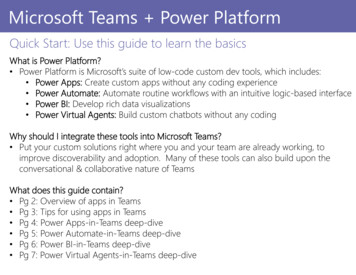
![NIAS EN COLOMBIA - Normas de Aseguramiento [Modo de compatibilidad]](/img/18/nias-en-colombia-normas-de-aseguramiento.jpg)
